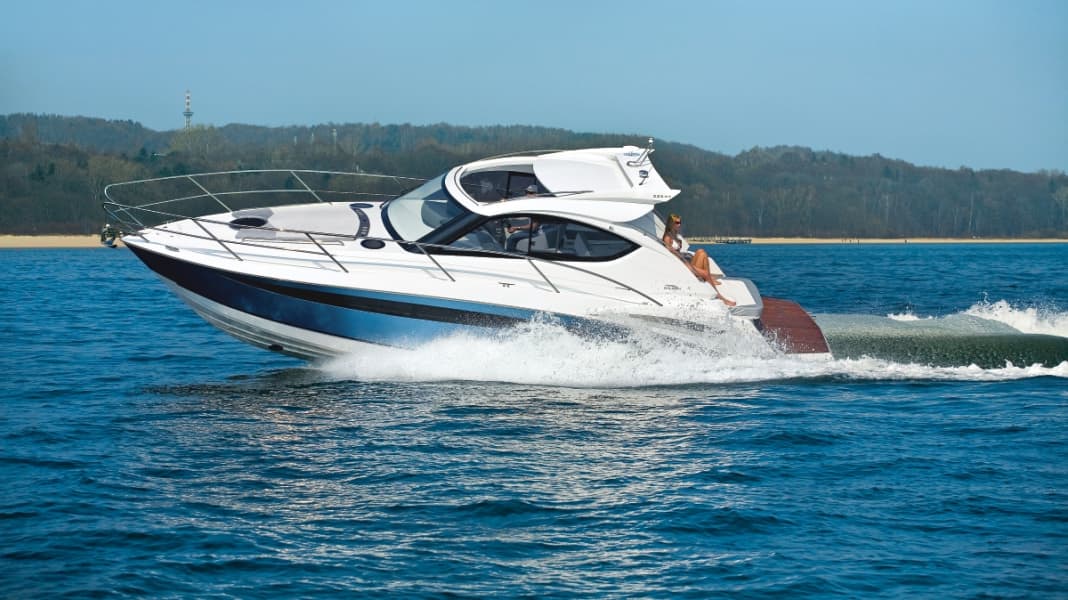

Galeon boats are currently available in seventeen variations from 29 to 78 feet in length. These include the Galeon 325, which is built in two versions, as an open or, like our test boat, with a hardtop. Our test Galeon is also a special edition, where the customer has had a say in the interior design. The 325 HT is usually built with a bow cabin, adjoining saloon with galley, toilet/shower room and underfloor cabin under the helm station and raised cockpit floor - typical day cruiser style. The design of the bow cabin and saloon has remained the same. Here, the customer has dispensed with the partition wall and door between the saloon and forward cabin, pulled the bench seat in the saloon slightly round at the front and had the bed built right up to it: open at the front with more living space.






Galeon is a byword for quality. We are therefore not surprised that we have almost nothing to criticise about the overall finish of our test boat, apart from a few minor details where some hoses rub on untreated cut edges. The 325 HT is manufactured using a vacuum process, which results in smooth interior surfaces in addition to other advantages such as weight savings. On the outside, there is high-quality gelcoat and a copper-coloured paint finish on the fuselage sides and hardtop. Inside, the work of the upholsterers and furniture makers is impressive. The fact that almost everything apart from the electronics and engines is manufactured in the shipyard itself is not commonplace and is intended to guarantee quality down to the last detail.
Driving and manoeuvring
Our Galeon is equipped with one or two inboards with sterndrives. We drive two MerCruiser Magnum 377s, each of which delivers 320 hp to the crankshafts. With the twin pack, it can be turned almost on the spot when one gearbox is in forward gear and the other in reverse. With both drives in "ahead", a full circle measures just under two boat lengths, plus optional stern and bow thrusters, which also make it easy to negotiate tight parking boxes on the test boat. In the harbour we sail at a maximum of 1000 rpm, and in the canal we don't let the engines turn higher than 1200 rpm (6 knots) so that the waves generated by the boat remain flat. People moving around in the boat have no influence on the course or heeling. Synchronised engines running at the push of a button guarantee straight-ahead running.
The transition from displacement to planing speed is associated with longer visual obstructions, as it takes a moment for the test boat to lower the bow from 3000 rpm (13 knots) and then continue as a full glider. Our test boat is almost fully equipped and every storage space and wardrobe is occupied. The fuel and water tanks are in the upper filling range. The engines can turn between 4800 and 5200 rpm at full throttle. We measured a maximum of 4900 rpm. This is suitable for an almost fully loaded boat. The top speed is logged in our GPS at just under 37.5 knots. What the boat doesn't need at planing speed is power trim. We keep the drives mostly fully trimmed, because as soon as you trim a little, the boat starts to luff. The lowest planing speed we determine is 3500 rpm or 21 knots.
The analysis of our measurement data leads to an unusual result. At slow speed, one tank of normal petrol in the test boat provides a theoretical range of 215 nm, plus 15% reserve. That is normal. What is unusual, however, is that our test boat is not economical at high speeds as usual, but runs at almost the same consumption per nautical mile from 3500 rpm to full throttle. The calculated ranges then fluctuate between 133 and 134 nm plus reserve. This means that the test boat falls just short of our minimum requirement of 150 nm range. "Not quite fulfilled" is also the word for the sound pressure values, where our measuring instrument displays over
85 dB/A from 4500 rpm.
The Galeon 325 HT cuts a fine figure during extreme manoeuvres at top speed. In increasingly tight bends, it leans slightly towards the centre of the bend, brakes on its own to a fast displacement speed and accelerates again after steering out. The curve diameters are around three boat lengths at the narrowest point. The fact that you are more likely to be flying blind when turning to port is due to the design and the deep V-hull, as the boat tilts to port and the roof moves into the field of vision. Even with the sunroof open, visibility is not complete, as the spar is then in the field of vision. Over starboard it fits if you duck down at the driving position.
On the imaginary slalom course, we make the test boat sway safely over its longitudinal axis; when the rudder is pulled away, it follows the chosen course without complaint. You have to be careful when you lose speed that the stern sea doesn't roll into the cockpit because of the long bathing platform and you get your feet wet. For the same reason, it is also advisable not to run the engines higher than a maximum of 1100 rpm with reverse gear engaged. In contrast, the test point "rough water" on the Gdansk Lagoon, where some waves up to a maximum height of one metre are audible but comfortable to sail over, is largely free of criticism. It is normal for splash water to be sprayed onto the windscreen. There are windscreen wipers for this, but they leave a vertical strip in the centre of the windscreen unwiped and do not move synchronously, which is annoying in the long run.
Our test boat has a driver's seat with only the backrests offering some lateral support and a shock absorber in the standpipe to minimise impacts. The seating position can be adjusted and the seat cushion can be partially folded up for driving in a standing position. A raised standing surface can be folded out above the integrated footrest if you want to look out of the open sunroof. The seating position is comfortable, but visibility is impaired due to the tinted windscreen and the reflections on all sides. It is also not easy to read the flat instruments. The gearstick and rudder controls are ergonomic. Passengers sit or lie on a raised L-shaped bench seat opposite the driving position with little support.
Engine, tank, electrics
The engines can be accessed by electrically operating the rear cockpit bench seat and sun lounger at the touch of a button. Access from above is acceptable. Everything is clearly laid out and neatly stored. The batteries are in their own boxes. Everything needed to supply the boat is housed in the engine compartment: pressurised water system, hot water boiler, hydraulic pumps, fuel tank with pre-filters (without water alarm sensors) and solenoid valves to regulate the fuel flow. The power for the on-board power supply and engines is switched via relays in the owner's cabin on the panel, where the most important fuses are also located.
Security
The handling characteristics of the test boat are impressive here. Walkable surfaces are either covered with anti-slip structures or teak. Apart from the stern entrance door to the cockpit, which is too low, the interior dimensions are correct. We would like to see more handholds, especially in the cockpit. The bilge pump (automatic and manual) and fire extinguishing system are good.
Living and cockpit
In the test boat, the bow cabin in the form of an open lounger and the saloon form a living unit that can be separated by a curtain. On the port side, you can sit comfortably at the table on an L-shaped bench seat, and opposite you have the cabin crew's work area, which generally has nothing to complain about. Next to the galley is the WC/shower room, where the dimensions are suitable; the angular fittings are unsuitable. The entrance door to the owner's cabin under the driving position and cockpit is installed next to the companionway into the living area and next to the L-shaped bench seat. It is easy to stand in the entrance area and in front of the double berth, otherwise you have to bend down. There is plenty of storage space under the mattresses and in the sideboard as well as in a small wardrobe. One longitudinal window on each side wall, but only one porthole for ventilation is a little too small.
The main entrance to the cockpit is to starboard, past the sunbed and aft section of the U-shaped bench seat. If you lower the table, everything becomes a large lounger. If that's not enough, you can go to the foredeck. The test boat is extended by a large bathing platform with a folding bathing ladder under a cover.
THE WERFT SAYS
The Galeon 325 scores not only with an aggressive design but also with a balanced hull that is characterised by performance and manageability. The hardtop offers privacy and protection from the weather. When the sunroof and sliding windows are open, the boat almost becomes an open, combining great manoeuvrability, attractive design and excellent quality on and below deck.
WE SAY
What undoubtedly characterises the shipyard is the fact that it is able to build a boat that is individually tailored to the owner. The quality is right "from the top to the keel and from the bow to the stern". There is also nothing negative to say about the handling characteristics. In short, a boat that fits the bill all round.
Data sheet: Galeon 325 HT
- Shipyard: Galeon Boats
- Type designation: Galeon 325 HT
- CE category: B - Outside coastal waters
- Length: 10,90 m
- Width: 3,30 m
- Displacement: 6,45 t
- Price: 198.750,00 €


